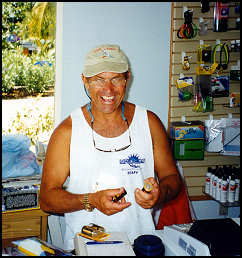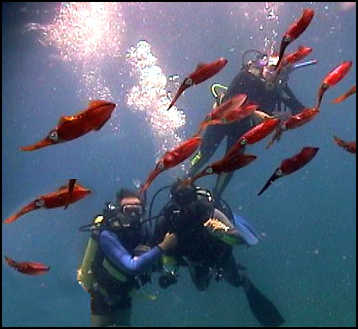| Spend any time at all in a Caribbean island
dive shop after admitting that you're not a certified diver and you are
bound to hear the above refrain. A loud voice in the back of your brain
will probably say something sarcastic like, "Yeah, but will I ever come
up again?"
So, what is this thing that the suntanned Caribbean SCUBA instructors so glibly call a "Resort Course"? Can anyone really do it? And, most of all, IS IT SAFE? |
 |
It consists of a lecture, a confined water session, and an actual 20 to 40 minute dive in the open ocean. Participants must be in reasonable condition to enroll. Translate this to read: one must be able to walk a mile in under eight minutes and sport healthy lungs and cardiovascular system. A simple medical checklist can be completed in less than five minutes and asks such questions as "Do you have asthma? Do you take prescription drugs? and my personal favorite, "Are you pregnant or attempting to become pregnant?"
Dive equipment has changed tremendously in the past 10 years and the explanation of the workings and use of buoyancy control devices, weight systems and regulators takes up most of the lecture portion of the half day course. By the end of this overview, the students will be familiar with the self-contained underwater breathing apparatus (more well known by its acronym - SCUBA) and the hazards attendant to its use. The student will also be familiar with the techniques used to equalize pressure within the sinuses, middle ear, and lungs.
Luckily, there are only a few things that the student needs to remember. The two most important of these are the need to equalize the internal and external pressures and the need to keep breathing at all times. It is the primary job of the instructor to be sure that the students understand the simple procedures used to satisfy these needs.
When the instructor, now referred to in some circles as the "professional SCUBA educator", is assured that his or her charges understand these few basic principles, they proceed together to the confined water or pool session. It is here that the students get practical, hands-on experience with such equipment as buoyancy compensators and SCUBA regulators.
Breathing takes on a whole new significance when you try it underwater for the first time. The best instructors ensure that each student is comfortable breathing through the regulator before proceeding. Do not let yourself be hurried at this point, as this relaxed, deep breathing is the key to successful diving.
Once all the students are breathing comfortably, the instructor will proceed with skills such as clearing water from the regulator and face mask. All required skills will be introduced in water shallow enough to stand, so that the student has only to lift his or her head to ask questions. This portion usually takes between 20 and 30 minutes. The time has now come for the students to venture into water over their heads. Here they practice equalizing increasing pressures as they head for the deep end of the pool, or if being taught from a beach, head out to deeper, but still confined, water.
After some practice giving and responding to hand signals, the students are ready to breathe off the instructor's alternate air source. This exercise is designed to instill a sense of confidence in both the student and the instructor. When both parties are assured that the students possess basic underwater skills, the group leaves the pool or confined water for the open ocean.
The open water portion of the course is "that incredible first dive"! Most divers remember their first experience for the rest of their lives. A dear friend and fellow diver refers to this as a "primary life experience." One never knows exactly what marine life will appear once the class goes underwater. Instructors can enthrall audiences for hours with tales of things they have encountered on resort course dives. Like the time I had a group of divers and and a huge school of colorful squid suddenly swam by...

It is a mostly friendly world down there and the type of things that dive instructors go agog over are not sharks and barracuda, but rather unusual little creatures like dwarf frog fish or porcelain crabs. Most instructors worry not about the marine life harming the divers but rather that the divers will harm the marine life, since coral reefs are among the most delicate assemblages of organisms on the planet. Each diver submerges with the responsibility to do as little damage as possible while visiting the underwater realm.
Fins can do tremendous harm when kicked close to the bottom, so students are cautioned to stop kicking when close to corals or other fragile marine life. Contrary to popular thought, one does less damage by settling down carefully than by finning mightily to stay off the bottom. The best course is to achieve buoyancy control during the confined water session and use the newly found skills to stay off the bottom unless one is in a locale featuring sand or a barren bottom. Even the most prolific reef will have several of these spots where the new diver can practice buoyancy control without harming the environment.
Whether you do your first dive on something like the famous "Wreck of the Rhone" in the B.I.V. or on a coral garden teaming with clouds of fish, it will undoubtedly be one of your personal vacation highlights. Who knows, maybe you'll quit the "real world", become a SCUBA instructor and move to the warm tropics. The author did.
[Randy Keil left the "real world" of classroom teaching and moved to the British Virgin Islands almost 15 years ago.]
Copyright (C) 1995-1999 Randy Keil
Randy Keil has dived all over the world, is a NAUI and PADI instructor, and was also certified by LA County. Randy is a free lance writer and has written articles for several British Virgin Island publications.